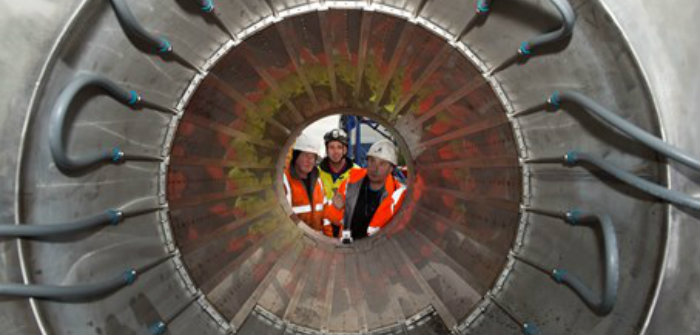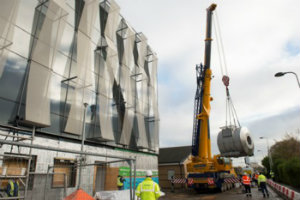Scotland’s first 7T scanner arrives at the QEUH
Published: 2 December 2016
The University of Glasgow, in partnership with NHS Greater Glasgow & Clyde, has taken delivery of Scotland’s first ultra-powerful 7 Tesla MRI scanner

The University of Glasgow, in partnership with NHS Greater Glasgow & Clyde, has taken delivery of Scotland’s first ultra-powerful 17.5 tonne 7 Tesla (7T) MRI scanner at the new Imaging Centre of Excellence (ICE) on the site of the Queen Elizabeth University Hospital (QEUH).
The new ultra-high resolution scanner – one of the world’s most powerful magnetic resonance imaging (MRI) machines – is also the first scanner of its kind in the UK to be located in a clinical setting. It will be situated on the grounds of Glasgow’s new super hospital, the QEUH.
The £10m 7T MRI scanner will be used to advance critical clinical research and will allow scientists and clinicians to study the human body in greater resolution than ever before, ultimately benefitting patients.
The 7T will offer researchers the opportunity to learn more about a host of health conditions, initially focusing on brain imaging to look at conditions such as small blood vessel disease of the brain, stroke, vascular dementia, brain tumours, Parkinson’s, Alzheimer’s Disease, epilepsy and multiple sclerosis.
The scanner will be housed in the University’s state of the art £32m ICE, which was made possible by £16m of funding by the UK Government and the Medical Research Council (MRC) via the Glasgow City Region City Deal, with further funding from other sources including the European Regional Development Funding, The Sackler Trust and the Dr Mortimer and Theresa Sackler Foundation.

Professor Dame Anna Dominiczak, Vice-Principal and Head of the College of Medical, Veterinary and Life Sciences at the University of Glasgow said: “The new 7 Tesla scanner is very important for the University of Glasgow, the city of Glasgow, Scotland and the UK.
“The scanner is an important ‘first’ for Scotland, which wouldn’t have been possible without £2.3m of European Union funding. The ability to form collaborations across Europe, and also bring skilled staff over from the EU to work on such advanced technology, will be a key part of the long-term success of the project.
“By locating the scanner at the Queen Elizabeth University Hospital, we are bringing advanced precision medicine technology closer to patients, making it arguably the most advanced imaging capability of its kind in the world for patient benefit."
Professor Keith Muir, SINAPSE Chair of Clinical Imaging (Stroke and Brain Imaging), who will be leading a clinical research programme using the 7T scanner, said: “The high magnetic field of the 7T scanner will allow extremely high resolution scanning of the body. This technology opens up the possibilities for new clinical and basic neuroscience research.
“In some conditions, looking at very small parts of the brain with the 7T scanner might make a big difference. In areas such as Alzheimer’s and some types of stroke, the areas of interest are very small – even microscopic – parts of the brain that we can’t see with the scanner technology that is currently available.
The 7T MRI scanner will be the centrepiece of the ICE building, which will become a cutting-edge centre for the advancement of precision medicine when it opens next year. The building will provide world-leading clinical research facilities and provide a hub for academic, scientific and NHS clinical expertise.
First published: 2 December 2016

